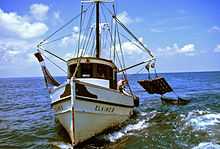Spey casting
Spey casting is a casting technique used in fly fishing. Spey casting can be accomplished with either a normal length fly rod, or a rod referred to as a double-handed fly rod, often called a Spey rod.[1] Spey rods can also be used for standard overhead casting.
Spey casting is used for fishing large rivers for salmon and large trout such as steelhead and sea trout. Spey technique is also used in saltwater surf casting. All of these situations require the angler to cast larger flies long distances. The two-handed Spey technique allows more powerful casts and avoids obstacles on the shore by keeping most of the line in front of the angler.
History
Spey casting originated in the heart of Scotland in the mid-1800s. The name came from the River Spey in Scotland, which is where the cast originated, presumably at Gordon Castle Estate and Wester Elchies beat. Therefore, the Spey cast was developed so one could successfully cast on a large river such as the Spey. When Spey casting was introduced, 22-foot rods were used. These rods were made of greenheart, a heavy wood imported from British Guyana. Today, rods are only 12 to 15 feet in length, and can toss a line up to 80 feet.
There are two groups of Spey casts, the "Splash and Go" and the "Waterborne Anchor". Splash and Go casts contain a backstroke that is in the air. The line then falls to the water, and the forward cast starts as soon as the tip of the line touches the water. The Waterborne Anchor casts are a little different, as they contain a backcast that stays on the water. In these types of casts, there isn’t a requirement to achieve perfect timing in order to forward cast after.[2]
While there are many variations of the Spey cast, the basic technique is broken down into a few simple actions.[1][3] With the fly line floating directly downstream, the angler first lifts the line off the water with the tip of the rod. The angler then sweeps the line backwards just above the water, and allows just the fly and leader to "anchor" the cast by touching the water one to two rod lengths away. This back-cast is often referred to as the "D-loop", from the curving shape of the line between the anchor and the tip of the rod. While swinging the "D-Loop," it is important to make one continuous, deliberate motion with the rod tip climbing at a 45-degree angle off the water. As the "D-Loop" comes around, the cast is completed by firing the line forward with a sharp two-handed "push-pull" motion on the handle of the rod while making an abrupt stop with the rod tip at the end of the cast. The cast is most easily compared to a roll cast in one-handed fly fishing, although by using the fly as an anchor, a Spey cast allows a greater loading of the rod and thus achieves greater distance than a one-handed cast.
Styles of Spey Casting
The two most commonly used styles of Spey Casting are the "Single Spey" and the "Reverse Double Spey". The Single Spey cast can be considered the most useful. It casts the line the farthest, and it can be used with winds blowing upstream. This cast is part of the "Splash and Go" group of casts. These are the most common steps to achieve a Single Spey cast: 1. Feed however much line you want to cast into the river, letting it drift downstream. 2. Make sure you're facing downstream with the rod pointing down. 3. Which ever way the stream is flowing, hold the bottom grip of the rod with your hand that is on the downstream side. 4. Now rotate so your upper body is facing upstream but your rod remains facing downstream. 5. Lift the rod up so almost all of the line in the river is out of the water. 6. Quickly, before the line hanging in the air sags, drop the tip down and smoothly pull the rod up and upstream at the same time. 7. The fly should come back to you, and right before it kisses the water, raise the tip as if you were going to make a roll cast, and make a powerful forward stroke. 8. The fly should end up on the other side of the river. [4]
The Reverse Double Spey cast is easier than the Single Spey. It is useful in strong winds, however, it cannot be used in when the wind is blowing upstream. In addition, you must be familiar to the roll cast, and the reverse casting techniques. These are the most common steps to achieve a Reverse Double Spey cast. 1. Start with the line and fly downstream. 2. Pull the rod upstream, keeping your rod low and your right arm extended. 3. Make a slight upward curl of the rod and move the rod horizontally level across your body back downstream to the left. 4. Now pull the rod up into the reverse position on your left shoulder. 5. Execute the power stroke forwards to launch the line in the direction your rod is facing. [5]
This technique was developed on the River Spey in Scotland.[3]
See also
References
- ↑ 1.0 1.1 Cook, Jack. "Spey Fly Fishing - Demystifying the Two Handed Rod". Retrieved 2009-05-19.
- ↑ Gawesworth, Simon (2004). Spey Casting. Mechanicsburg, PA: Stackpole.
- ↑ 3.0 3.1 Dean, Floyd. "Spey Casting". Retrieved 2009-05-19.
- ↑ Rosenbauer, Tom (2007). The Orvis Fly-fishing Guide. Guilford, Connecticut: Lyons. pp. 91–96.
- ↑ Falkus, Hugh (1994). Spey Casting: A New Technique. London: Excellent. pp. 99–105.
Further reading
- Gawesworth, Simon (2004). Spey Casting. Stackpole Books. ISBN 0-8117-0104-2.
| |||||||||||||||||||||||||||||||||||||

